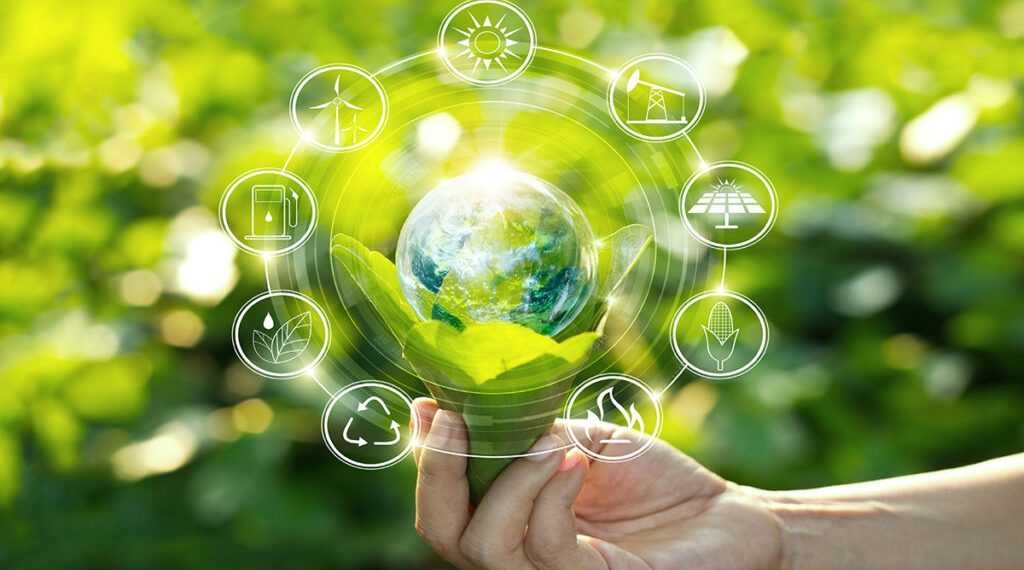Our world (and ourselves) will continue to thrive for a very long time thanks to green technology, also known as sustainable technology, environmental technology, or clean technology.
How Does Green Technology Work?
Any technology that is ecologically friendly is considered “green technology.” It is based on environmental science and takes the environment into account. But it goes deeper than that. Technology that is “green” is created to have a positive impact on the environment.
Consider recycling, renewable energy sources, and energy efficiency as examples. These are all components of green technology that are used to create green products or goods that are made with the environment in mind.
Green technology is more important now than it has ever been. As a result of climate change, sea levels are increasing due to melting icecaps and unpredictable weather patterns that result in more earthquakes, hurricanes, tornadoes, floods, and droughts than in the past and other hazardous events.
Green technology may not be able to solve all of these issues, but it can undoubtedly make a difference by offering products that are more environmentally friendly and encouraging actions that are better for the earth.
Typically, green technology is solely interested in one component of sustainability: environmental health. A more general term, sustainable technology, includes problems with the economy, society, and environment.
Examples of Green Technologies
You may not be aware of it, but you undoubtedly already utilize green technology on a regular basis. Here are some instances of green technology that you might be familiar with:
- Electric vehicles: With Tesla, Elon Musk is on to something. Environmentally friendly electric automobiles are more prevalent. These cars are considered green technology because they don’t use fossil fuel and emit no emissions, which is better for the environment.
- Programmable Thermostats: You probably assumed that the Nest thermostat was just a fun gizmo. Green technology called programmable thermostats schedules interior environmental changes (keeping your home warm or cool), so you don’t spend energy when you’re not at home. Most also offer tools that inform you of the settings that are most favorable to the environment.
- Solar panels: People have installed solar panels as a way to lower the cost of powering their houses since they can collect energy from the sun that can be stored and delivered as needed. Solar energy systems are a substantial source of energy in some places, such as Hawaii.
- LED Lights: That LED light bulb you put in the lamp does more than just provide light. The environment and you are both spared from utilizing fossil fuels to light your surroundings. Additionally, because intelligent LED lights can be programmed or controlled remotely, you can switch them off when you leave if you remember to do so from your smartphone at work.
- Wind Energy: Similar to solar panels, wind energy can lessen the need for conventional power sources, hence lowering the amount of carbon discharged into the atmosphere. Even home windmills can contribute to the electricity grid, but wind farms and offshore wind turbines are the most typical examples.

Farmland
Have you ever thought about how much farmland is used only in the United States? What if we could grow our food indoors and let that land revert to its natural state? It’s taking place. Farmers will be able to produce food hydroponically indoors in much less space than an outdoor farm would need, thanks to vertical farming. Additionally, vertical agriculture minimizes the amount of water consumed and water pollution caused by conventional farming practices.
How Green Technology Affects You
Perhaps more frequently than you think, you already employ green technology, and that’s a good thing. Cities and municipalities all over the world continue to make prudent investments in green technology, according to Alec Jahnke, Sales Engineer at Digi International, for two very important reasons.
“First, the health and vitality of neighborhoods and the residents who dwell there can be drastically changed by technology like the Internet of Things (IoT). Modern IoT sensors and communication tools can improve operations that would otherwise depend on fossil fuels, use other natural resources, and unnecessarily increase our carbon footprint, “He clarifies.
IoT technologies, he claims, also put the “green” in green technology by generating sizable cost advantages in nearly every way imaginable, from precision agriculture to electric vehicles and alternative energy facilities to “smart cities” projects like optimized LED streetlights and traffic management.
In a time when post-pandemic budget concerns are present at all levels of government, IoT lowers costs while enhancing both our environmental impact and quality of life, according to Jahnke.
Going forward, you’ll see more green technology, and by making even the tiniest changes, you’re likely to develop habits that are better for the environment. It’s also beneficial to begin actively considering what you can do to benefit the environment (and preserve your way of life). It’s simple to start!
Here are a few concepts:
- Buy a recyclable phone case.
- Repurpose an outdated laptop or PC.
- Dispose of batteries properly.
- Invest in a solar charger.
- Recycle obsolete electronics for your home theatre.
- The planet can benefit from even one forward stride. Why are you holding out?
The primary aims of green technology
Fundamentally, green technology attempts to safeguard and repair the environment, preserve natural resources, and repair past environmental harm. Green technology’s primary objective is to use clean energy to reduce the damaging effects of new technologies on the environment (alternative fuel sources and technologies that do less harm than fossil fuels). However, it also has the following extra objectives:
- Discovering new approaches to satisfy our wants while minimizing our detrimental effects on the environment.
- Reducing waste, pollution, and resource use inefficiencies.
- Substituting new eco-friendly technologies for older ones.
- Dispatching new eco-friendly technologies and generating employment to support them.
How are these green technology objectives achieved?
Thanks to the efforts of green technology businesses that make use of science-based technologies and techniques, the aforementioned objectives can be achieved. These businesses frequently include financial, social, and environmental sustainability in their business models. Additionally, by turning a profit, green tech companies may expand and maintain their operations while increasing the beneficial influence they have on the earth and minimizing their carbon footprint.
Corporate carbon emissions reduction has emerged as a key component of company strategies. As a result, an increasing number of businesses made the commitment to becoming carbon neutral. One business that has committed to becoming completely carbon neutral for both its supply chain and its goods by 2030 is Apple.






